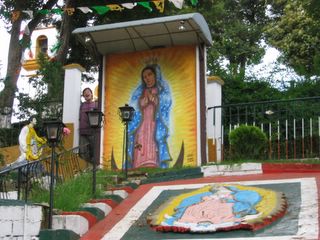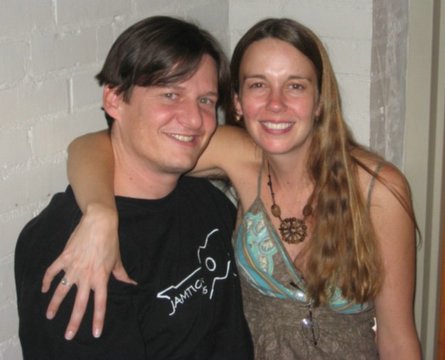
Palenque, with Pakal's temple (left) and the palace (right)
Palenque is described as one of the most impressive of the ancient Mayan cities, 2nd in most people’s estimation only to nearby Tikal (across the border in northern Guatemala). Like Tikal, Palenque is simultaneously breath-taking (for the contrast between the ancient stone temples and the surrounding tropical jungle) and mind-boggling (for the fact that most of these impressive buildings were constructed over 1500 years ago, half a world away from the presumed cultural centers of the world in Europe and Mesopotamia). Discovered by the Spanish in the 1700s, Palenque (palisade in Spanish, certainly not its original name) was the gateway through which archaeologists have uncovered many of the mysteries of the ancient Mayan civilization, including the ruins of a number of other ancient cities hidden in the jungles of this region.
The Mayans apparently rivaled the ancient Romans and Greeks in sophistication, developing scientific mathematics, astronomy, engineering feats, advanced agriculture, and even their own calendar (the Tzolkin, still in use today in some indigenous villages descended from the ancient Mayans). Religion is another matter, however, as the Mayans worshipped a variety of gods (including a corn god, in deference to their primary source of subsistence; the Mayans were possibly the first to domesticate and cultivate corn) and practiced some literally heart-wrenching forms of human sacrifice. Their civilization peaked from AD 100 to 900, after which all of these impressive cities were mysteriously abandoned, possibly due to an enormous natural disaster. No one knows for sure, since the Spanish did not arrive for another 600 years, and the ancient cities were all completely grown over by dense jungle. The survivors had relocated to various nearby mountainous highland villages, where their descendants mostly remain to this day, now divided into over 2 dozen tribes (all speaking their own language) spread throughout southern Mexico, western Belize, Guatemala, and western Honduras.

Ancient carving depicting a Mayan ruler
Today at least half of the pyramid-shaped temples and palaces at Palenque have been restored to something resembling their original form (minus the bright red, blue and yellow colors that reportedly adorned the buildings in their prime). Also much of the jungle has been cleared away and replaced with grass in the center area around the most impressive structures, making for some very scenic photo opportunities. However there are still several clusters of smaller temples that have not been restored. Set back amidst the dense jungle and left mostly in the form in which archaeologists discovered them, these crumbling structures have little discernible form, and many even have huge trees growing right out of the tops of them. It was nice to see both restored and un-restored ruins to gain a deeper – and humbling – perspective.

The view from Templo de Flores

The big temple that contains the ruler Pakal's tomb

Rabbit Skull!

Carley on the temple with the Rabbit Skull

In the ruined palace...

Templo de Flores (flowers)

Exploring

Some un-restored ruins
There is definitely something dizzying and deeply philosophical about being in a place so ancient. You can simultaneously feel both insignificant and connected to something larger while walking through the tunnels and rooms and thinking of those that walked them over a thousand years before you.
We spent the night at a campground called Mayabell, in a small jungle village called El Panchán, just outside the gates to the park that encloses the ruins. El Panchán is a hangout for travelers from all over, and you can find everything from campgrounds to a resort here, all set amongst dense jungle. From the incredible assortment of sounds emanating from the jungle (especially at night!), this area is apparently home to a rich variety of wildlife, including the legendary howler monkeys, which sound more like some vicious wild dogs or large cats than monkeys. Trying to fall asleep in the tent with such a cacophony outside was an adventure in itself!
The Mayabell campground was really nice, featuring several grassy areas for pitching a tent, a number of thatched-roof cabañas, an on-site restaurant with a performance space for local and traveling bands, and even a swimming pool. However, the swimming pool would pale in comparison to the nearby natural swimming holes, as we would learn the next day…
On to DAYS 29-30: Jungle waterfalls at Agua Azul, Misol-Ha and Agua Clara






